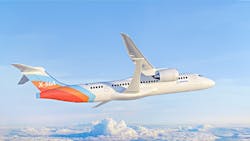The strut rides again
ARLINGTON, Va., - The Cessna 120, introduced in 1946, bequeathed its strut-braced wings to nearly all of its successors, making struts and single-engine Cessnas almost synonymous. It wasn’t always so. In the 1930s, Cessna built airplanes like the C-34, a clean radial-engine four-seater with a cantilever wing. The demise in 1954 of the C-34’s all-metal descendant, the 190/195, left the Cessna universe to strut-braced singles. So things remained until 1967, when cantilever wings appeared more or less simultaneously on the 177 Cardinal and the 210, Peter Garrison writes for Flying. Continue reading original article.
The Military & Aerospace Electronics take:
18 August 2023 - Flying's Garrison notes that strutted and braced-winged aircraft have been around as long as flying, but fell out of favor when fixed-wing aircraft came into the picture as monoplanes looked to reduce drag to fly faster and further.
Boeing says that the technologies demonstrated and tested as part of the Sustainable Flight Demonstrator (SFD) program will inform future designs and could lead to breakthrough aerodynamics and fuel efficiency gains.
Earlier this year, the National Aeronautics and Space Administration (NASA) tasked Boeing with building a proof-of-concept airplane, dubbed the Transonic Truss-Braced Wing (TTBW) utilizing trussed wings to demonstrate fuel savings opportunities with the technology, which could increase 30% while reducing emissions in equal measure.
When combined with expected advancements in propulsion systems, materials and systems architecture, a single-aisle airplane with a TTBW configuration could reduce fuel consumption and emissions up to 30% relative to today's most efficient single-aisle airplanes, depending on the mission. The SFD program aims to advance the civil aviation industry's commitment to reaching net zero carbon emissions by 2050, as well as the goals set forth in the White House's U.S. Aviation Climate Action Plan.
Ultrathin wings braced by struts with larger spans and higher-aspect ratios could eventually accommodate advanced propulsion systems that are limited by a lack of underwing space in today's low-wing airplane configurations. For the demonstrator vehicle, Boeing will use elements from existing vehicles and integrate them with all-new components.
Related: U.S. airlines to support NASA-Boeing sustainable flight demo project
Related: NASA awards Boeing sustainable flight demonstrator contract
Related: Strutted airliner might replace 737
Jamie Whitney, Senior Editor
Military + Aerospace Electronics
